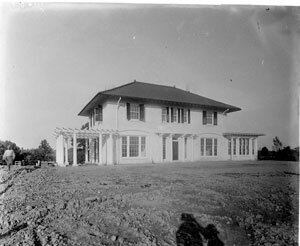ONARCHITECTURE- Scholarly debate: Will Bradbury house become history?

Eugene Bradbury's historic Robert Compton House on Maury Avenue was designed in 1913.ALBEMARLE CHARLOTTESVILLE HISTORICAL SOCIETY
Last week, the Albemarle County Industrial Development Authority approved $21 million in bond financing to help the Jefferson Scholars Foundation construct a new 23,000-square-foot headquarters on the corner of Maury Avenue and Clark Court. While most people would agree that the Foundation does important work, providing funds to attract the very best students to UVA–full tuition, fees, and generous stipends are handed out to over 50 incoming graduate and undergraduate students each year– preservationists are worried that the new headquarters could mean the destruction of a local architectural treasure.
When Daniel Bluestone learned earlier this year that the Foundation had paid $3 million for the Maury Avenue property, site of famed architect Eugene Bradbury's Robert Compton House(commonly known as the "Beta House" fraternity), the UVA architectural historian says he began trying to encourage the Foundation to save the building, but to no avail.
"I immediately contacted [Foundation president] James Wright to encourage the preservation of the house," says Bluestone, "but he never made time to meet me, despite repeated efforts. I met him for the first time at the public meeting."
Indeed, Bluestone says he was the only person to speak at the public hearing portion of the Authority meeting last week, where he argued for the building's preservation and reuse.
Who is Eugene Bradbury?
Bluestone says that Bradbury– who worked in Charlottesville from 1907 to 1927– snagged many of the choicest local commissions, including St. Paul's Church, the Kearney Mansion atop Lewis Mountain, the entrance building at UVA, three houses on the east side of Rugby Road where it intersects with Rugby Avenue, the Bank of America building on the Downtown Mall, the Chi Phi fraternity house, Four Acres and the Goodwin House on Rugby Road extended, and other private residences.
Indeed, Bluestone believes that the Compton House, built in 1913 for Dr. Robert F. Compton, an ear, nose, and throat specialist at UVA, is one of the most important houses built in Charlottesville in the last century.
In the architectural history books, according to Bluestone, Bradbury is recognized as a "regionally inspired classicist," meaning he was most certainly inspired by Jefferson's work and other architects inspired by the third President, and sought to further that kind of classical aesthetic by working in the ne0-Jeffersonian and Georgian Revival modes that characterized the American Renaissance.
However, Bluestone says history may have overlooked Bradbury's deep understanding of Jefferson's ability to root his designs in the topography and geology of a site. As Bluestone writes in a history of the Compton House, "Bradbury stretched the Compton house elevation across 65 feet, including a one-story sun porch to one side and an attached pergola to the other. These porous architectural elements forged a clear reciprocity between the house and the site. The spectacular red terra cotta roof that extended towards the ground on projecting rafter tails pulled the site and its Albemarle red clay into a powerful design relationship with the house."
Back to the future
While Bluestone says that preserving the past while building for the future can present difficult choices, he believes the Compton House isn't one of them. The house is still solid, sits well back on its 1.6-acre lot, and could be easily integrated into the planned headquarters.
In addition, he points out that the estimated cost of the new headquarters is nearly $500 a square foot, while preserving the 4,600-square-foot Compton House would cost considerably less. (In a town where some buildings are created for less than $100 per square foot, just the borrowing on the new headquarters rings up a total development cost of $913 per square foot!)
The Foundation has expressed interest in pursuing a sustainable, LEED-certified design, but as far as Bluestone is concerned, the most sustainable thing the Foundation can do is to find a way to adapt the Compton House.
While the Foundation's Wright has said that no final decision has been made concerning the house, at last week's hearing he told the IDA that "preservation might not be an option because of extensive damage done by fraternity brothers over the years," according to a story in the Daily Progress. "They were tough on that house," Wright added.
Although Wright could not be reached for comment by press time, Bluestone confirms his statements.
"If this house is demolished," says Bluestone, "the Jefferson Scholars Foundation will have turned out to be much harder on this house than decades of frat brother partying."
Bluestone isn't the only preservationist coming to the defense of the Compton House. Garth Anderson, vice-chair of the Albemarle County Historic Preservation Committee, and Gina Haney of Preservation Piedmont, both let the Foundation, the Authority, and the County Board of Supervisors know by email prior to the hearing how significant they believe the house to be.
As a practical matter, County supervisors David Slutzky and Dennis Rooker both pointed out that the County had no authority to impose any conditions on the bond issue regarding historic preservation, given the fact that the property is in the City. While Slutzky says he's sympathetic to the plight of the Compton House, he says it's up to Charlottesville City staff to decide what's best. Since the project is in its early stages, it has not yet come before City planning staff. But given the fact that the Compton House isn't designated historic, preservationists are bracing for a fight.
"I think we knew that the County couldn't make demands of the City, or would even be willing to tie it to the bond issuance," says Anderson, calling his own comments and those of Bluestone and Haney "a shot across the bow to the Foundation and the City that there are those of us who are concerned about the future of the Compton House."

The Compton House has always been more commonly known as the "Beta House" fraternity.
PRESERVATION PIEDMONT
#